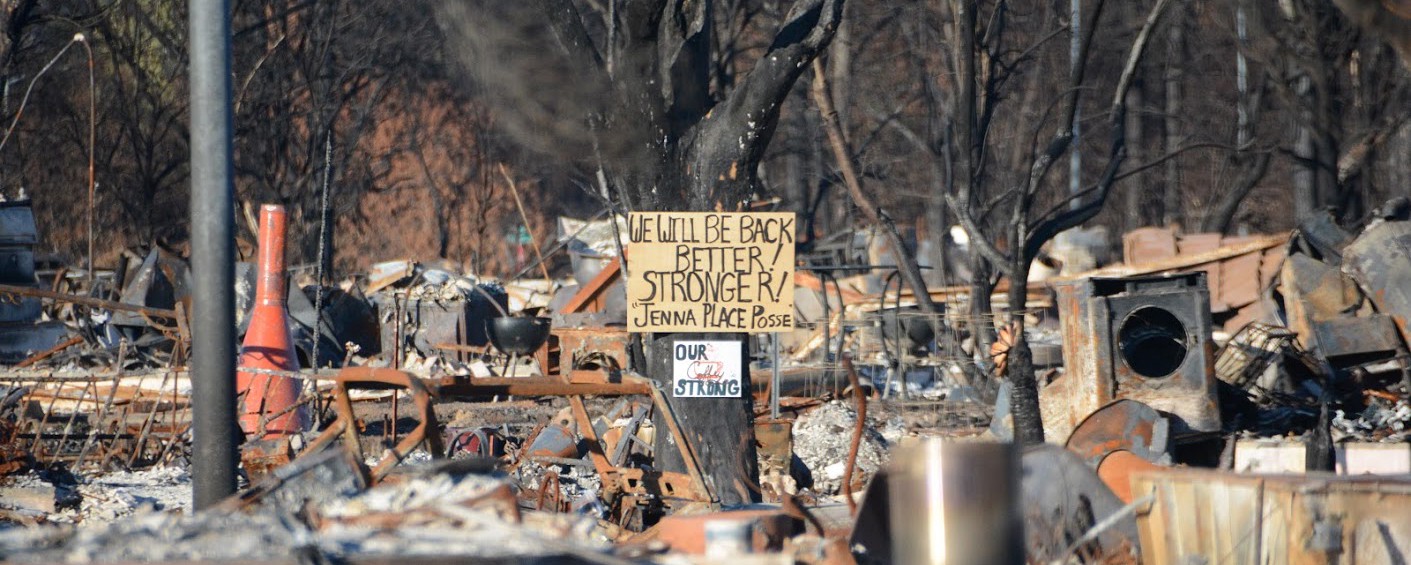

This is first and foremost a letter of recommendation: take some time this weekend to sit down and read Christina Nichol’s essay “An Account of My Hut,” from the Spring 2018 issue of n + 1. It is about last October’s deadly fires in Northern California, and about homes and communities, and, above all, about climate change–the way we talk about it, and the way we feel it.
Climate change is a tricky thing for humans to both think about and talk about–a clash between the pace of change, how that change is happening, and the way we process time. Nichol does really interesting things with time and perception in her essay, simultaneously balancing the frustration of inaction and helplessness a lot of us feel about climate change with everything happening at once as the fires burn. The fires themselves are the sort of natural disaster that moves in tricky timescales, much like the unsteady paths of hurricanes; the anxiety comes in the anticipation, in the uncertain space of time before the fire reaches your door–if it reaches your door at all.
There were a lot of things I found striking about the essay–I’m thinking especially about a long, extended description of the fragments of burned-up paper she found during the fire. “I was looking for stories,” she writes, “but I could only find information.” It’s such a haunting image, endless scraps of paper falling from the sky: romance novels and Bible verses and journal entries (“so many pages of people talking to themselves”).
But one of the things I found most interesting was the tension around community. Early in the piece, discussing George Marshall’s Don’t Even Think About It: Why Our Brains Are Wired to Ignore Climate Change:
After spending fifteen years studying climate change””denying microcultures, Marshall concluded that facts don’t change people’s minds; only stories do. We’re so motivated by wanting to belong that we’d rather risk the dangers of climate change than the more immediate symbolic death of estrangement from our peers. In order to address climate change in our communities, Marshall suggests, we must appeal to the same desires that religion does: for belonging, consolation, and redemption.
In the essay, Nichol seeks to solve climate change through community by literally joining a group working together to change attitudes. But later she talks about how people who don’t believe in climate change are less likely to do so after natural disasters. It’s paradoxical, sure, but she cites Marshall again, who says that since a sense of community grows after natural disasters, people are less likely to push back against nonbelievers; they’re just simply trying to survive, communally.
Thinking about this paradox makes me feel a bit paralyzed. It’s hard to spur people to action when nothing dramatic is happening–it’s so hard for us to see climate change happening in real-time, because it’s working on scales largely invisible to the human eye–but it’s nearly impossible to capitalize on the obvious proof of it all when dramatic things are happening.
I live less than a block from New York Harbor; when the winds shift on a warm day, my fifth-floor apartment can smell a bit brackish. During Sandy, I lived maybe half a mile south, four blocks from the harbor and in thin strip of white on the colorful evacuation zone map, between the dual flood zones of the harbor to the west and the toxic sludge of the Gowanus Canal to the east.
It was impossible not to think about my neighbors in the days and weeks following the storm, once the waters had receded from our streets and efforts turned to helping people whose homes had been utterly destroyed. But now, the streets are dry, and while it’s probably easy for us to dredge up memories of Sandy, to imagine the next storm, doing much about climate change, communally, remains a different story.
There are many reasons we seek community, but one of them is the power of the shared narrative–the ideas that we can form in groups, whether we’re bound together by something as abstract as ideology or as concrete as geography. When you live through a natural disaster, it can be hard to contextualize it in a broader landscape. But as the frequency of natural disasters increases, they will cease to be isolated incidents; we will be able to see the patterns more clearly, because we’ll be feeling them.
Throughout her essay, Nichol is met with pushback at the doom-and-gloom that any mention of climate change invokes. She grudgingly compares herself to her father, whose too-blunt warnings about climate change agitated everyone around him:
When my brother announced that his wife was pregnant, my dad told him he wouldn’t need a college fund since there wouldn’t be any college in the future. My brother, who was tenderly grilling ribs, threw down his barbecue fork and said, “For once I want to talk about life, and not always be focused on the end!” After that, climate change became a forbidden topic on holidays. Now I was rediscovering what I’d understood as a kid: people don’t respond well to threats, to cajoling, to end-of-the-world scenarios, to dystopian futures, to hopelessness.
We want to be able to talk about life, and not always be focused on the end. It’s hard to think about the end when life is constantly getting in the way. But can we learn to think about what’s next without thinking only of the end?


How We Get To Next was a magazine that explored the future of science, technology, and culture from 2014 to 2019. This article is part of our Nature & Climate section, which looks at how human activity is changing the planet–for better or worse. Click the logo to read more.
